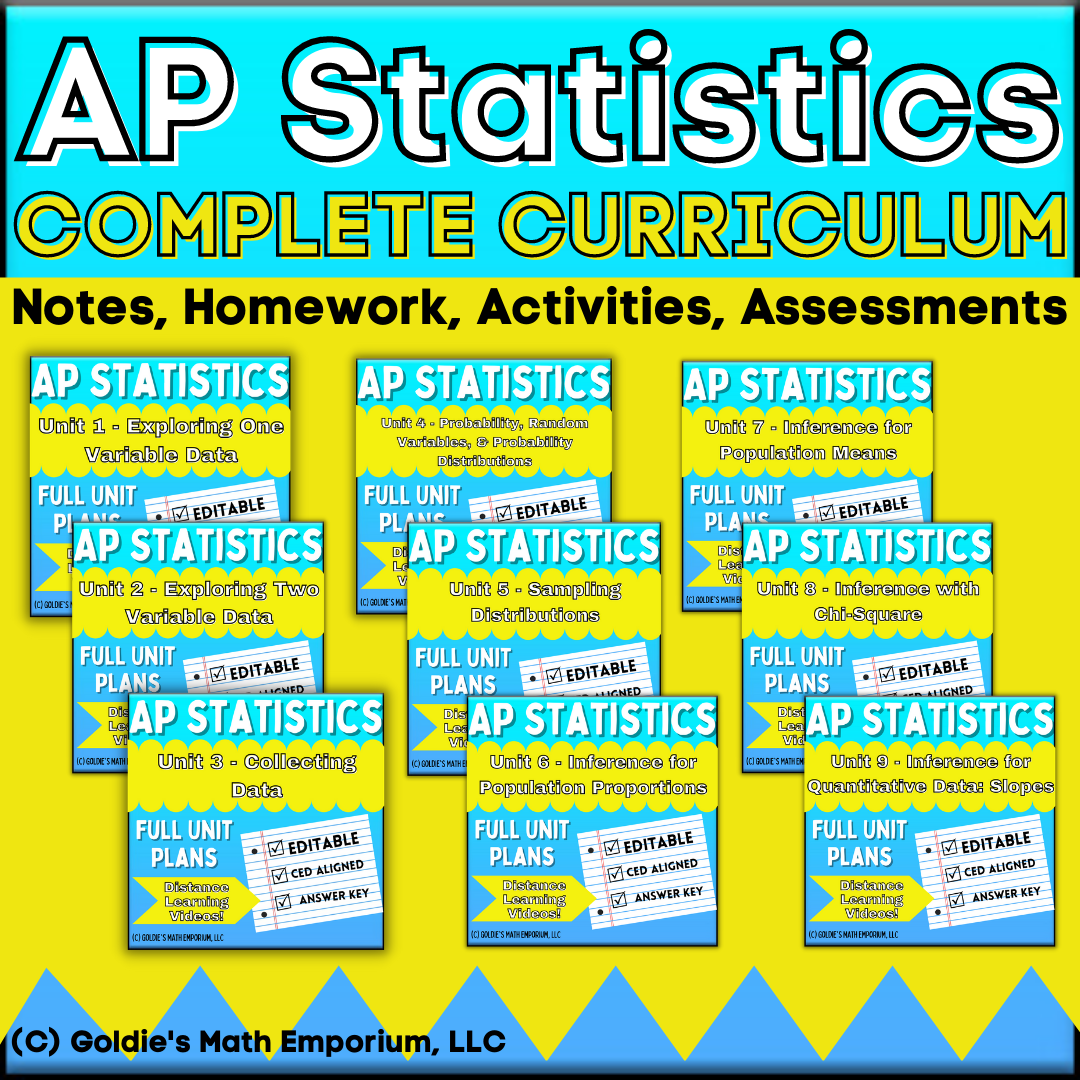Hello fellow educators and statistics enthusiasts!!
As a passionate teacher who believes in making quality education accessible to all, I am thrilled to share a collection of free AP Statistics resources that I have personally developed and successfully used in my own classroom. My goal is to empower both educators and students on their AP Statistics journey. I know not everyone is able to put forth their own money to add resources to their classroom, so I hope to help out as much as I can with these amazing pieces for your class!

The resources below are listed based on the AP Statistics unit they fall into from my AP Statistics Full Curriculum. Some of these resources would also be a great fit in an “on-level” statistics course as well!
Unit 1 – Bar Graphs and Dotplots M&M Activity
In this activity, students will use a fun size bag of M&Ms to create a bar graph; they will use the class data to create a class bar graph; and they will use the class individual data to create 6 separate dot plots. Students will then be asked about the difference between the bar graph and the dot plot that they created from the same data. There is also an extension on this activity, that asks students to create a pie graph by hand.
Click here to get this activity!
Unit 2 – Vitruvian Man Activity
In the first part, students gather the class’s data on their height and their armspan. They plot the data and are taken through the difference between a line of best fit and the least squares regression line (using what they learned in Algebra). They are taught the steps to create an LSRL from their TI-84 calculator, and then use that line to interpret data. Finally, they are shown how to calculate the LSRL by hand from the summary statistics (part of the AP Statistics CED) and check that it matches the LSRL they got on their calculator. In the second part, students gather the class’s data on their height and handspan. Then, the activity is completed on their own, taking them through the same steps (with less instruction) as part 1.
Click here to get this activity!
Unit 3 – Sampling and Experiments Review Lesson
This lesson reviews the following concepts:
- The difference between an observational study and an experiment
- The different types of sampling methods
- How to select a random sample using a table of random digits
- The different types of bias
- The four principles of a well-designed experiment
- Completely randomized design, block design, and a matched pair design
- Experimental vocab
- The scope of inference in an observational study and experiment
Click here to get this activity!
Unit 4 – Binomial vs Geometric Random Variables Organizer
In this organizer, students compare binomial and geometric random variables by looking at the different conditions when we use these random variables, how we define X and our probability of success, how we calculate P(X = x) and P(X <= x), how we view these in a table, and how we find the mean and standard deviation of these variables.
Click here to get this activity!
Unit 5 – Sampling Distributions Review Lesson
In this lesson, you get teacher slides and a student handout to help review all the material involved when teaching Sampling Distributions.
Click here to get this activity!
Unit 6 – Inference for Proportions Circuit Activity
In this activity, students practice confidence intervals and significance tests for proportions. There are 14 problems in a circuit-style activity, where students are asked various types of questions to test their knowledge on One Sample Confidence Intervals for Proportions, Two Sample Confidence Intervals for Proportions, One Sample Z Test for Proportions, Two Sample Z Test for Proportions, and Errors in Significance Tests.
Click here to get this activity!
Unit 7 – Walk the Line Activity
I use this as an introduction to significant tests for means. I claim that the average distance a student can walk in a straight line, while blindfolded, is 40ft. We set up a spot in the hallway with tape, blindfold the students, and see how far they can walk the line before they step off. This is a great way to introduce both confidence intervals and significance tests for means.
Click here to get this activity!
After Unit 7:
These summary sheets are great for comparing all the different types of confidence intervals and significance tests we have done so far! Click on the links to be taken to these resources.
- Confidence Intervals Summary Sheet
- Significance Tests Summary Sheet
- Difference in Populations Summary Sheet
As educators, we understand the challenges of providing high-quality learning experiences on a limited budget, and my aim is to alleviate some of that burden. I recognize the financial constraints many educators face, and by offering these resources for free, I hope to contribute to creating a more equitable educational landscape. Let’s continue to collaborate and share our expertise to empower students and fellow educators alike. Together, we can inspire a love for statistics and foster a generation of critical thinkers. Happy teaching!



0 Comments